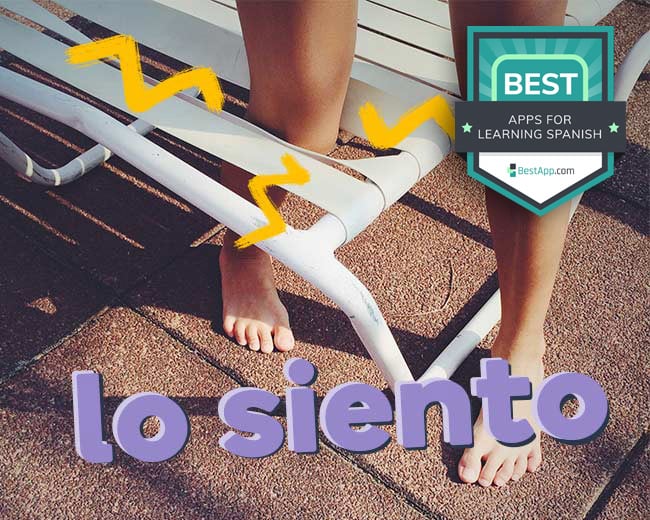Saying sorry isn’t always easy. Whether you’ve got into an argument, accidentally bumped into someone or just made a mistake, knowing how to say sorry in Spanish can be useful. If you find yourself in a situation where an apology is necessary, it can be handy to know what to say and when to say it. Different situations call for different things! (To see a whole range of different Spanish scenarios, check out our Spanish Video Phrasebook). Don’t sweat it though, we’ve got you covered. Below we’ve listed how to say ‘I’m sorry’ in an array of different scenarios. Next time you find yourself in a tricky spot, you’ll know exactly what to say.
Different ways to say ‘I’m sorry’ in Spanish
There are several ways to say sorry, but the three most common ones are:
“Lo siento”
This is the most common phrase for sorry, and is mostly used in informal situations. For example, if you make a mistake you would say “lo siento” to express saying sorry. You wouldn’t use “perdón” (see below) because if you used perdón, it would mean that you were to blame for the death of the pet! To show a stronger sense of sorrow, you could say, “lo siento mucho” (“I’m very sorry”) Hear a native speaker say it now!

“Perdón”
This is another way of asking for forgiveness. Commonly used in Mexican Spanish alongside “perdóname'', it can be used if you bump into someone, need to quickly use something that belongs to someone else or interrupt someone when they’re talking - think mistakes that deserve recognition but aren’t really serious. (Take a peek at a variation of this apology here!)

“Disculpe”
This is the most formal option. It’s generally used in workplace situations or asking permission. If you have friends from Mexico, they’d say “disculpa” or “discúlpame” If, for example, you wanted to enter into a room in a workplace scenario (or another serious situation) you should say “disculpe” rather than “lo siento” or “perdón”. This is because you’re simply asking for permission in a polite way, you’re not apologising for something you’ve done wrong. So, when it comes to asking permission, use “disculpe”.

Distinguishing between the three
The key distinction between the three main ways to apologise in Spanish are generally as follows: Lo siento is used for expressing sorrow, perdón is used for admitting blame for something and disculpe is used to ask permission or in very formal situations. For scenarios where you could use all three, you can use the situation to judge which word you should use. From least to most formal, apologies go as follows: lo siento, perdón, disculpe.
Making a mistake in Spanish
When you’re learning a new language, it’s really common to make mistakes. It can also make you think “What if I embarrass myself or worse, offend someone else?” 😱 Look at you, embarrassing yourself - you may as well just become a recluse now, you can never face the world again after that slip up… Not! Obviously, everyone hates embarrassing themselves or, god-forbid, offending someone else. But you’ve got to bear in mind that when speaking Spanish (especially as a beginner) it’s common to make a mistake or two.
If you’re sitting there, head in hands, plagued with doubts and (probably unlikely) scenarios of how you might embarrass yourself when chatting with a native Spanish speaker, then you need to give yourself a little talking-to. (In a nice way, of course) As you practice Spanish and make mistakes along the way (more on this just below) you’ll quickly progress and start understanding how to express yourself and your emotions more clearly. Our advice is, don’t overthink things! You’re a bad-ass who’s taken on the challenge of learning a new language. You’re going to smash it.
What do I do if I offend someone?
Hey, if you do offend someone, you can always apologise! There’s nothing wrong with making a genuine mistake - in the long run it’ll help your learning. Another handy Spanish phrase is “I’m sorry, I got confused” (Lo siento, me equivoqué) armed with this and a classically apologetic smile, people are way more likely to cut you some slack.
Back to mistakes: The fear of making them (and in turn, embarrassing yourself) is a huge barrier when it comes to learning Spanish. But rest assured that native Spanish speakers will appreciate your attempt and the effort you’ve gone to to try - they’ll probably even help you out by finishing your sentence or gently correcting you - #winning! Our final tip is be patient. The more you speak Spanish, the less you’ll worry, and that takes time.
Saying sorry (informally)
If you’re with friends or in an informal situation, you can use either lo siento or perdón, but lo siento is most common. For example, lo siento is commonly used for if you don’t want to reveal a secret (e.g. “Lo siento, pero no puedo contarte lo que pasó en la fiesta.” - I’m sorry but I can’t tell you what happened at the party.) Or, if you did something accidentally, or want to offer your condolences, then lo siento is the one to choose.
Saying sorry (formally e.g. office/work situation)
Disculpe is the word you should use when you’re in a formal situation, like a workplace, or asking something to someone you don’t know. For example, when asking for directions from a stranger, you should begin with ‘disculpe’. If you’re trying to get someone’s attention or ask for a favour from them, you should also use ‘disculpe’.
Saying sorry (for a loss)
To offer your condolences and to say sorry for your loss, you can use lo siento or lo siento mucho. However, using lo lamento is more appropriate in this situation. Lo lamento comes from the verb “to regret” (lamentar), and is much stronger emotionally. For example, you can use it to say “I’m sorry for your loss” – Lamento tu/su pérdida.
Saying sorry to loved ones (wife, husband, etc)
Depending on what you’ve done, you can use either lo siento or perdón when saying sorry to a loved one. For example, if you’ve had an argument with your sister or partner, and it was your fault, you’d use ‘perdón’, but if a family member told you they hadn’t got a promotion at work, you would say ‘lo siento’.
So now you know how to say sorry, and the different situations you might be in where you need to apologise, you can keep learning Spanish successfully! Keep jumping into learning Spanish and little by little, you’ll become more comfortable with the language. If you enjoyed this post, head to our Spanish learning homepage!









